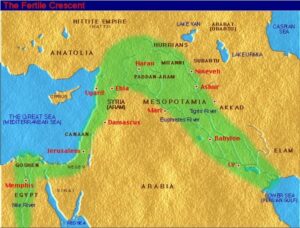Fertile Crescent

Çatalhöyük, Hacılar and Beycesultan are the first examples of the first housing culture created by the mankind in the world.
Civilization began in Anatolia around 6000 BC with the Neolithic town of Çatal Höyük.
The first known human settlement is in Çatalhöyük, Turkey (7 Millennium BC).
Mesopotamia has long heen considered as the first home of civilization in the Old World, about the fifth millennium BC, but the so-called neolithic revolution or transition to so-called agricultural society about 10,000 BC probably occurred first in Anatolia.
The origin and ethnic derivation of the most ancient inhabitants of Anatolia are not known, but it is certain that they were among the first if not the first, to have built a city. Before that, between 15,000 and 13,000 BC, we know only of nomadic hunters, as at Lascaux.
At Çatal Höyük in the middle of the Anatolian plateau, a cluster of the first real houses was discovered on an area of thirteen hectares. They were constructed from clay bricks, the walls were regularly colour-washed on the outside, and certain of them were covered on the inside with wall paintings, similar to cave drawings but fulfilling an aesthetic function. Linked together in tiers, the upper houses opened onto the flat roofs of the ones below.
The fourteen levels built up there correspond to a little more than one thousand years of occupation, from 6750 BC to about 5600 BC, that is to say, during the Neolithic period.
These first ‘town dwellers’ were primarily farmers. They lived in family groups of five to seven persons, and were already cultivating wheat and vines, raising sheep and goats, and keeping dogs. They grew and wove flax, and possessed weapons of copper and lead, both for hunting and defense. They also traded with distant countries. At Çatal Höyük objects have been found made of volcanic glass and apatites which were unknown locally.
The first Neolithic paintings found on man-made walls are in Çatalhöyük, Turkey.
Çatalhöyük is a center of “firsts” -first ceramic pots, first mirrors, first examples of woven materials, first wooden bowls, first wallpaints, among many other firsts.
Our soul, which started to take shape as 9/8 in Rumelia starting from the 14th century, is a lively and enthusiastic musical rhythm. The roots of our soul, which once again caught universality in Rumeli, were shaped in the depths of inner Asia with the seven concepts here. This spirit has three main elements: sky, earth and person. All three are created. A person’s life on earth, which is the world in question, is connected with the heavens, that is, the celestial universe shapes the person during his life.
From this point of view, the steppes of Inner Asia and Asia Minor became the vast spaces where contact with the heavens was established and the source of thoughts of the people. The thoughts of the people also fed the thinkers. The Silk Road steppes in Inner Asia and the Cappadocia region and surrounding areas in Asia Minor, Eskişehir, Ankara, Konya, Kırşehir, Niğde, Nevşehir line were the areas where the richest works were produced. The first examples that come to our minds were Yunus Emre, Mevlana, Hacıbektaş Veli, thinkers who grew up in the steppe .
Cappadocia, the middle point of Asia Minor, and the steppe and agricultural basin areas in the middle of Central Asia were the main centers of thought. The source thinkers, whom we consider as a reference in our work, always came from these fields in Central Asia. The nourishment of the sky, the sun and the moon, the rain and the breeze, made the person dynamic.
Turkish Belt
Turkish Belt, not the Turkish World. It is important that the TURKISH KENŞİ, which started out as the five fingers of one hand, turns into a TURKISH BELT as soon as possible by traveling around the world. Girdled will embrace. Relationships also gird the world. Turks living in 132 countries gave way to the formation of a Turkish BELT in the world.
While the term first appeared as a bond term in the Oguz Kagan Epic, it also showed itself in inscriptions and manuscripts. The concepts of World State in Farabi and Kut Belt in Kutadgu Bilig contain remarkable thoughts. Diaspora (Overseas Turks) and exonym (Foreign Turkish Yerads) gain importance when it comes to language.
The prevalence on the ground in terms of population and language has revealed the formation of a Turkish Belt. In addition, the compatibility with the civilizations on the ground has increased the prevalence even more. Similarly, although the Indians spread in the African continent and the Latins in South America, the Chinese could not spread and adapt outside their own countries except the USA.
The Turkish Belt has surrounded the world for 15,000 years, starting from Karahantepe and Göbeklitepe in Anatolia, with networks that surpass 5G technology. Turkey 5G Networks of Steppe ( Step ) and Agricultural Belt is a synthesis. Gaspirali, Galiyev and Gumilev in the list are Turkish intellectuals who have great influence on Russian Turkishness.
- Göbeklitepe (9600-8200 BC)
- Gokturk (552-744)
- İsmail Gaspıralı, 1851-1914,
- Sultan Galiyev 1880-1940
- Lev Nikolayevich Gumilev (1912-1992)
Turkey ranks first among the countries that give place names in their own language in countries in geographies outside their countries. Placenames in 100 countries are described as Turkish.
In terms of language, the Turkish language is spoken in 48 countries. The Turks, who internalized the geographies from Manchuria to Hungary together with the Steppe Belt, included the Mesopotamia-Anatolian publication in their coverage together with the Agricultural Belt. When all these data are evaluated together, what emerges is not a Turkish World devoted to a limited geography, but a Turkish Belt that surrounds the world.
The great steppe has been the biggest school of the nations it has hosted. The burning sun, freezing cold, deadly hurricanes, impassable mountains, impenetrable deserts have developed a will of steel in steppe people. Motun, Tonyukuk, Cengiz, Temür… These are the children of the steppe school. Source: Ali Akar. https://twitter.com/ali_akar/status/1267895190376808448
Western historians attribute the dominance of the Turks over the steppe to their ability to ride horses, draw bows, and shoot arrows. However, behind this domination was the accumulation of knowledge (mind), ukuş (understanding), bilig (knowledge) for thousands of years. From these came the power of the bow, arrow, and spear. Source: Ali Akar https://twitter.com/ali_akar/status/1267162827028140045
It is sad to forget the inscriptions (Yenisey, Orkhon, Altay) written on stone in the areas from Manchuria to Mongolia and Hungary, as if they were written on ice, starting from 1500 years ago along the steppe belt. To expand the delayed entry of the printing press, which was developed 500 years ago in the West, to our country is the ignorance of not knowing that the printing press actually existed in the Uyghurs and that the Turks started their printing business in the 800s and gave the first examples on this subject, which is an even sadder feeling.
The Steppe Belt and the Fertile Crescent
5G: The Largest Networks of 12,000 Years…
5G: Steppe (Step) and Agriculture Belt synthesis
On the map, ORDOS is the intersection of the starting point of the yellow steppe belt south of Beijing , where the Yellow River bends.
- Yellow Belt: Steppe highway.
- Red frame: Uyghur/East Turkestan
- Green Belt: Agricultural Belt/ Fertile Crescent
It is obvious what kind of mobility we have provided from Beijing (Beijing) to Budapest.
From the Ordos plains in the Yellow River to the Danube plains, grazing their horses on the steppe plains, the Turks traveled along the yellow belt, from Far Asia to Eastern Europe, and later settled in East Turkestan (Uyghur) and Transoxiana and settled in Iran, Iraq. They reached Anatolia via Syria.
Another fact that the 1071 discourse ignores is that it ignores the Turks who settled and settled in Eastern Europe and the Balkans from the yellow belt, referring only to 1071, and referring to them as the Turkish-speaking Byzantine soldiers in the Romanian Diogenes army.
Bulgars, Uzs, Ogurs, Avars, Cimmerians, Cumans are the essential elements of the human material of nearly twenty states in Eastern Europe and the Balkans.
Main Stations:
- Uyghur Turkestan
- Transoxiana /Bukhara, Samarkand/
- Khorasan
- Iran
- Anatolia
- Damascus
- Baghdad
- Cairo
- Rumelia
Our Geography and Basins , from the Blue Danube tribes in Bavaria to the plains of the Yellow River in the downstream of Manchuria
The first ancient concepts of our civilization began to form in the Yenisei Basin in the Altai (Siberia, Russia) around 3000 BC, from there to the Orkhon Basin (Mongolia) and then 1000 BC. The 2000-year-old culture and civilization accumulated in the 1950s moved to the Ordos region in the Yellow River Basin (China), and after forming the idea of the Chu State, the first Chinese State, the first Turkish State, the Hun State, was established in the early 200s BC by Oguz Kagan.
On the way to the Turkestan oases (Turfan, Kaşgar, Yarkent, Kuça, Hotan), the civilization formation that will come to light began with the works of Kaşgarlı Mahmud and Yusuf Has Hacip in the 1000s AD.
The journey to the West continued with Transoxiana – Great Horasan – Caspian Basins this time; There was a golden age between the years 700 -1100, when the great thinkers of Turkish culture grew up; Ancient concepts have been enriched with Islam.
Before the last Rumeli stop on our Ancient Journey, we reached the region surrounded by the Five Seas and reached Anatolia, Mesopotamia and the Nile lengths, and the Cihan State drawn by Oğuz Kağan.
“ Let the sun be a flag, the sky is a tent”
mission; It was carried out centered in Rumelia, and dominance was established in the continents of Europe, Asia and Africa.
Old world/Middle of the world
The Mediterranean region; The region surrounding the Mediterranean.
- 10 BC / 3rd by BC – 5th century / Nile-Amudarya region
- 5 BC – 5th century AD /Fertile Crescent
- AD 700 – 1200/Darül Islam
Western hegemony; It is based on the middle of the East, the Middle East. Our civilization is based on the middle of the world. This middle is the Mediterranean. It is the middle of the old world; Mediterranean, Mediterranea.
Our civilization is of the Old World; It was formed in the Yellow River – Orkhon – Amudarya – Nile – Mediterranean regions.
- East Asia (Karakorum, Karabalsagun, Orhun, Ötüken),
- Central Asia (Turfan, Kucha, Kashgar)
- South Asia (New Delhi, Punjab, Lahore, Agra),
- Transoxiana (Samarkand, Bukhara, Khiva),
- Khorasan (Tus, Nishapur),
- Nile (Cairo, Alexandria)
- Mediterranean (Thessaloniki, Algeria);
Our Islamic Civilization grew in the Mediterranean basin and expanded from Spain to beyond the borders of China.
In the middle of the region between Transoxiana and Andalusia, the Nile river is located. The distance between Transoxiana and China is the same as the distance between Transoxiana and Andalusia. It seems that; The borders of our sovereignty areas, which are lined by seas on all four sides, are the Pacific Ocean in the East, and the Indian Ocean in the South; It is surrounded by the Black Sea in the north and the Mediterranean in the west.
Oğuz Kağan’s legacy of “more seas, more rivers” has come true. Hungary is also called Hungarya, Bulgaria is also Bulgaria; One of the names of both communities, their connection with Turkishness is evident. In fact, the EU is a project related to the suppression of Turkishness that hung up to Vienna and shook Rome as well. They marketed the entire Balkans to themselves. Eastern Rome had already assimilated the Turks in the Balkans by Christianizing the Cumans, Pechenegs, Bulgars and Avars.
Talking about the cafes of Paris, London, and Barcelona, the foreign Turks’ imagination and reasoning describe the existence of Isfahan, Lahore, Karachi, Damascus, Kashgar, Xian, Kazan, Skopje. Not even a crumb of fame, Adis Ababa, Seville, Andalusia’s coffeehouses, coffee houses and teahouses exist, nor even the crumbs of their thinkers.
Let’s quickly put the references of the East on our agenda together; Let’s talk about Harezmi, Konevi, İbnül Arabi, Hamidullah, Fazlurrahman, Mohammed İkbal, Kaşgarlı Mahmud, Ferdovsi, Gaspıralıs, Niyazi-i Misri and their thoughts, starting with Oğuz Kagan.
The Hong Kong subway logo is inspired by the characters of the Chinese alphabet thousands of years ago. http://goodlogo.com/download/mtr_hong_kong_logo_vector_3620
Why can’t we share the same thought for the logo of the Istanbul metro, because there is neither the art of calligraphy nor the art of marbling, the heirloom of ancestors, in that logo, both of which have their roots in the depths of Asia. The lack of effort in the intellectual structure and the cultural shallowness have condemned us to an ongoing drought, and the ways out of this seem to be related to the cultural centers of our past and how we can feed on the cultural resources produced by these centers.
Intellectual shallowness actually concealed a deep cultural depth.






















